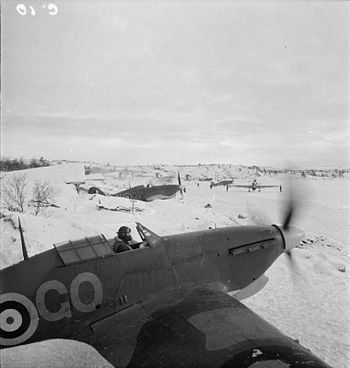Operation Benedict
| Force Benedict | |
|---|---|
 A Hawker Hurricane Mk.IIB of the No. 151 Wing RAF at Murmansk |
|
| Type | Re-inforcement and joint RAF / VVS operations |
| Location |
Kola Peninsula Coordinates: 67°00′00″N 36°00′00″E / 67.00000°N 36.00000°E |
| Planned by | Air Marshal Charles Portal |
| Objective | Protect North Sea convoys from Luftwaffe and Suomen Ilmavoimat air forces |
| Date | 29 July 1941 to 6 December 1941 |
| Executed by | No. 151 Wing RAF and 72ndSAP |
| Casualties | 1 killed |
Force Benedict was an operation during World War II in which a fighter aircraft Wing of the Royal Air Force (RAF), together with the units of the VVS (Voyenno-Vozdushnye Sily - soviet air forces), were deployed against the Luftwaffe (German air force) and the Suomen Ilmavoimat (Finnish Air Force) over the North Sea.
On 22 June 1941, the Soviet Union was attacked by troops of the Third Reich and Axis powers, and as a consequence, the Allied Power of Great Britain was also considered attacked. In the framework of the resolved military assistance for this country (Lend-Lease Act), Winston Churchill commissioned the British ambassador in Moscow, Stafford Cripps, to explore the options for collaboration. On 27 June, Cripps submitted the proposal of a British/Soviet operation to protect the convoys that were scheduled to travel through the North Sea to the destination ports of Murmansk and Archangelsk to the Soviet Minister of Foreign Affairs Vyacheslav Molotov. At the same time, pilots of the VVS were briefed on British aircraft in order to be able to use them at a later date. During discussions in London on 9 July between British admirals and a Soviet delegation, as well as a cabinet session by day appointed for this purpose, the proposal was confirmed.
On 12 July 1941, a British commission met representatives of the Royal Navy (RN) and the RAF in Murmansk to review the circumstances in the field. On their recommendation, a decision was made to use the Vaenga airfield for the operation. The contingent was originally meant to consist of two squadrons of Hawker Hurricanes and one squadron each of twin-engined Bristol Blenheims and Bristol Beaufighters. In the end, the commander-in-chief of the RAF Charles Portal decided on 25 July to send only the Hurricane squadrons; No. 81 Squadron RAF (81 Sqn) and No. 134 Squadron RAF (134 Sqn) were deployed on 29 and 31 July, and consolidated into the No. 151 Wing RAF (151 Wing), equipped with a total of 39 aircraft and 550 men, pilots and ground crew. Neville Ramsbottom-Isherwood was appointed their commander. The pilots had been taken from 81 Sqn and No. 504 Squadron RAF (504 Sqn) or had just completed their training.
...
Wikipedia
